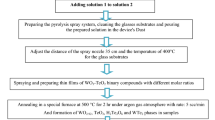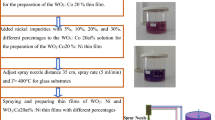Abstract
In this paper, WO3–TeO2 binary thin films were deposited by spray pyrolysis. By changing the stoichiometry between WO3 and TeO2 in initial solution, three samples with various molar ratios were prepared including: (a) WO3 (0.15 M)–TeO2 (0.05 M), (b) WO3 (0.1 M)–TeO2 (0.1 M), and (c) WO3 (0.05 M)–TeO2 (0.15 M). Then, deposited binary thin films were characterized by XRD, FE-SEM, and I–V cyclic voltammetry to study electrochromic and coloration properties of the thin films before and after annealing at T = 500 °C. The XRD analysis of the samples shows the formation of the H2Te2O6 phase with the preferred peak of (2 0 0), which increased with TeO2 content after annealing. The WO3–TeO2 thin films were used as a binary combination of n-type (WO3) and p-type (TeO2) semiconductors to investigate the change in electrochromic properties before and after annealing at T = 500 °C. The results of the hysteresis I–V curve of the WO3–TeO2 binary combination showed that by increasing the H2Te2O6 phase, the electron–hole exchange and, consequently, the coloration/bleaching process are improved. The area under the hysteresis curve varies in the range of 11.02 \(\times {10}^{-3}\) to 88.32 \(\times {10}^{-3}\) A.V. The diffusion coefficient also varies in the range of 1.96 \(\times {10}^{-12}\) to 7.09 \(\times {10}^{-12}\) cm2/s.
Graphical abstract












Similar content being viewed by others
References
Somani RP, Radhakrishnan S (2002) Electrochromic materials and devices: present and future. Mater Chem Phys 77:117–133
Granqvist CG (2008) Oxide electrochromic: why, how, and whither. Sol Energy Mater Sol Cells 92:203–208
Granqvist CG (2002) Handbook of inorganic electrochromic materials. Elsevier, Amsterdam
Deb SK (2008) Opportunities and challenges in science and technology of WO3 for electrochromic and related applications. Sol Energy Mater Sol 92:245–258
Hoseinzadeh S, Ghasemiasl R, Bahari A, Ramezani AH (2017) n-type WO3 semiconductor as a cathode electrochromic material for ECD devices. J Mater Sci: Mater Electron 28:14446–14452
Wang ShJ, Ch WM, Chen ShF, Li YH, Shen TS, Bor HY, Wei CN (2018) Electrical and physical characteristics of WO3/Ag/WO3 sandwich structure fabricated with magnetic-control sputtering metrology. Sensors 18(9):2803
Berkaïne N, Orhan E, Masson O, Thomas P, Junquera J (2011) Nonlinear optical properties of TeO2 crystalline phases from first principles. Phys. Rev. B 83:245205
Moufok S, Kadi L, Amrani B, Khodja KD (2019) Electronic structure and optical properties of TeO2 polymorphs. Res Phys 13:102315
Li Y, Fan W, Sun H, Cheng X, Li P, Zhao X (2010) Structural, electronic, and optical properties of α, β and -TeO2. J Appl Phys 107:093506
Guo Sh, Zhu Z, Hu X, Zhou W, Song X, Zhang Sh, Zhang K, Zeng H (2018) Ultrathin tellurium dioxide: emerging direct bandgap semiconductor with high-mobility transport anisotropy. Nanoscale 10:8397–8403
Tishkevich DI, Grabchikov S, Lastovskii S, Trukhanov S, Zubar T, Vasin D, Trukhanov AV (2018) Effect of the synthesis conditions and microstructure for highly effective electron shields production based on Bi coatings. ACS Appl Energy Mater 4:1695–1702
Tishkevich D, Grabchikov S, Zubar T, Vasin D, Trukhanov S, Vorobjova A, Yakimchuk D, Kozlovskiy A, Zdorovets M, Giniyatova Sh, Shimanovich D, Lyakhov D, Michels D, Dong M, Gudkova S, Trukhanov A (2020) Early-stage growth mechanism and synthesis conditions-dependent morphology of nanocrystalline bi films electrodeposited from perchlorate electrolyte. Nanomaterials 10:1245
Kharade RR, Mali SS, Mohite SS, Kondalkar VV, Patil PS, Bhosale PN (2014) Hybrid Physicochemical synthesis and electrochromic performance of WO3/MoO3 thin films. Electroanalysis 26:2388–2397
Meenakshi M, Sivakumar R, Perumal P, Sanjeeviraja C (2016) Studies on electrochromic properties of RF sputtered vanadium oxide: tungsten oxide thin films. Mater Today Proc 3S:S30–S39
Yano M, Kuwagata W, Mito H, Koike K, Kobayashi Sh, Inaba K (2018) Electrochromic properties of epitaxial WO3 thin films grown on sapphire substrates. Jpn J Appl Phys 57:100309
Karaca GY, Eren E, Cogal GC, Uygun E, Oksuz L (2019) Enhanced electrochromic characteristics induced by Au/PEDOT/Pt microtubes in WO3 based electrochromic devices. Opt Mater 88:472–478
Vorobjova A, Tishkevich D, Shimanovich D, Zdorovets M, Kozlovskiy A, Zubar T, Vinnik D, Dong M, Trukhanov S, Trukhanov A, Fedosyuk V (2020) Electrochemical behaviour of Ti/Al2O3/Ni nanocomposite material in artificial physiological solution: prospects for biomedical application. Nanomaterials 10:173
Jittiarporn P, Sikong L, Kooptarnond K, Taweepreda W, Stoenescu S, Badilescu S, Truong VV (2017) Electrochromic properties of MoO3-WO3 thin films prepared by a sol-gel method, in the presence of a triblock copolymer template. Surf Coat Technol 327:66–74
Bo G, Wang X, Wang K, Gao R, Dong B, Cao L, Su G (2017) Preparation and electrochromic performance of NiO/TiO2 nanorod composite film. J Alloy Compd 728:878–886
Tholkappiyan R, Naveen AN, Vishista K, Hamed F (2018) Investigation on the electrochemical performance of hausmannite Mn3O4 nanoparticles by ultrasonic irradiation assisted co-precipitation method for supercapacitor electrodes. J Taibah Uni Sci 12:669–677
Shirpay A, Bagheri Mohagheghi MM (2018) The effect of chemical reduction conditions on the structural and optical properties of WO3–TeO2 binary compounds by controlled synthesis from oxide precursors. Appl Phys A 124:627
Porqueras I, Bertran E (2000) Efficiency of Li doping on electrochromic WO3 thin films. Thin Solid Films 129:377–378
Gesheva KA, Cziraki A, Ivanova T, Szekeres A (2007) Crystallization of chemically vapor deposited molybdenum and mixed tungsten/molybdenum oxide films for electrochromic application. Thin Solid Films 515:4609–4613
Bachvarova-Nedelcheva A, Iordanova R, Kostov KL (2019) Synthesis, structure and properties of silver tellurite glasses. Mater Res Express 6:125202
Wang K, Zeng P, Zhai J, Liu Q (2013) Electrochromic Films with a Stacked Structure of WO3 Nanosheets. Electrochem Commun 26:5–9
Weng KW, Han S, Chen YC, Wang DY (2009) Characterization of tungsten–titanium oxide electrode for electrochromic applications. Appl Surf Sci 255:3848–3853
Ivanova T, Gesheva KA, Popkirov G, Ganchev M, Tzvetkova E (2005) Electrochromic properties of atmospheric CVD MoO3 and MoO3–WO3 films and their application in electrochromic devices. Mater Sci Eng B 119:232–239
Bai L, Yuan R, Chai Y, Yuan Y, Wang Y, Xie Sh (2012) Direct electrochemistry and electrocatalysis of glucose oxidase-functionalized bioconjugate as a trace label for ultrasensitive detection of thrombin. Chem Commun 48:10972–10974
Zhou KL, Wang H, Liu J, Yan H (2018) The mechanism of trapped ions eroding the electrochromic performances of WO3 thin films. Int J Electrochem Sci 13:7335–7346
Leftheriotis G, Papaefthimiou S, Yianoulis P (2007) Dependence of the estimated diffusion coefficient of LixWO3 films on the scan rate of cyclic voltammetry experiments. Solid State Ionics 178:259–263
Chaichana S, Sikong L, Kooptarnond K, Chetpattananondh K (2018) The electrochromic property of MoO3/WO3 nanocomposite films. IOP Conf Series: Mate Sci Eng 378:012002
Dalavi DS, Devan RS, Patil RA, Patil RS, Ma YR, Sadale ShB, Kim IY, Kim JH, Patil PS (2013) Efficient electrochromic performance of nanoparticulate WO3 thin films. J Mater Chem C 1:3722–3728
Ertaş FS, Kaş R, Ünal U, Birer Ö (2013) Sonochemical synthesis and electrochemical characterization of α-nickel hydroxide: precursor effects. J Solid State Electrochem 17:1455–1462
Christy AG, Mills SJ, KAMPF A R, (2016) A review of the structural architecture of tellurium oxycompounds. Mineral Mag 80:415–545
Author information
Authors and Affiliations
Corresponding author
Additional information
Handling Editor: Kevin Jones.
Publisher's Note
Springer Nature remains neutral with regard to jurisdictional claims in published maps and institutional affiliations.
Rights and permissions
About this article
Cite this article
Shirpay, A., Mohagheghi, M.M.B. Effect of H2Te2O6 and TeO2 phases on structural and electrochromic properties of WO3–TeO2 nanostructured binary thin films. J Mater Sci 56, 14644–14658 (2021). https://doi.org/10.1007/s10853-021-06233-1
Received:
Accepted:
Published:
Issue Date:
DOI: https://doi.org/10.1007/s10853-021-06233-1




